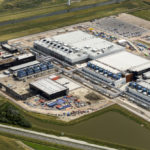What are boards on a roof called?

There are two types of protective board that can be used on a roof and what they are called depends upon where they are placed:
- A ‘roof cover board’ is placed below the waterproofing layer
- A ‘roof substrate board’ or a ‘roof board’ sits directly over the structural deck
The boards can be specified either individually or together, and their use can bring benefits to the overall performance of the roof.
When do they get used and how do they improve the performance of the roof?
The position of roof cover boards allows them to influence the performance of both the waterproofing layer above and the insulation layer below.
A roof cover board that is compatible with an adhered waterproof layer can increase the adhesion of the waterproofing layer to improve its resistance to wind uplift. Where the system is mechanically fixed, the wind uplift can be improved by the strength of the cover board and the provided pull out resistance. The boards also present a smooth, hard surface below the waterproofing that can increase its resilience to punctures and damage – reducing the likelihood of water ingress to the building below.
As well as offering protection to the waterproofing layer, the roof cover board sits over the insulation layer. In this position it can offer additional resistance to the insulation from compression by any heavy plant on the roof or from foot traffic from walkways or during maintenance.
If non-combustible roof cover boards are used, they may enhance the fire resistance of the roof should a fire start on the outside. If the fire burns through the waterproofing layer, the cover board underneath offers extra fire resistance that may slow down the spread of the fire, reducing damage before the fire can be extinguished.
Roof boards, in contrast to roof cover boards, are placed directly over the structural deck and can affect the performance of the roof from a different position. When placed directly over the deck, a non-combustible roof substrate board can help increase the fire resistance of the roof by providing an additional thermal barrier. If a fire starts on the inside of the building, this extra barrier can offer additional protection against the build-up of heat for any combustible insulation that is installed above the board and can also slow down the spread of heat along the underside of the deck.
The boards also create a flat surface over profiled decking to make the installation of vapour control layers and insulation boards easier. When used with compatible adhesives they increase the area available for bonding of the vapour control layer / insulation and this can increase the adhesion between layers to provide enhanced resistance to the forces of wind uplift.
The additional density offered by the inclusion of roof boards can also help enhance the overall acoustic performance of the roof by reducing the transmission of noise through the roof. This extra weight can also add to the structural integrity and rigidity of the deck.
Can cover boards and roof boards be used together?
Both boards can work together to provide the roof with extra enhancements depending on the project specification performance requirements. Using both boards in a system can give extra fire resistance to the roof from attack by fire from both inside and outside the building. Using both boards can also bring improved acoustic performance and increase the overall wind uplift resistance of the roof.
Georgia-Pacific has a range of DensDeck®, non-combustible, glass mat faced gypsum core, roof boards (A1 in accordance with EN 13501-1 and non-combustible as described and tested in accordance with ASTM E136). They are available as both roof cover boards and roof substrate boards. If you would like to discuss how one, or both, could be suitable for your next project please contact one of our team today.
Contact Us
Start your project or simply get specification advice by dropping us a message.
One of our team will be in touch as soon as possible.